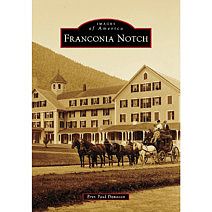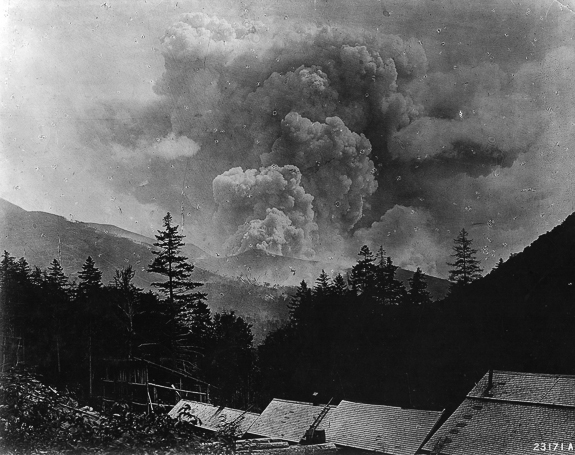Owl's Head Mountain Fire August 17, 1907 – During the late 1800s and early 1900s, logging activities from railroad logging contributed to a number of forest fires in the New Hampshire White Mountains. Sparks from locomotives were responsible for starting fires along the railroads. And the logging slash (unwanted part of the tree left behind after an area is logged) left on the mountainsides fueled the forest fires.
The infamous August 1907 Owl’s Head Mountain fire in the Pemigewasset Wilderness was started by a lightning strike on the eastern side of Owl’s Head Mountain in an area that had been previously logged by J.E. Henry and Sons. The included color photographs show the general area of where the forest fire took place.
The fire burned for days, and the smoke could be seen from miles away. An estimated 10,610 acres of forest burned in the area surrounding Owl's Head. The above 1907 photograph shows the forest fire from logging Camp 13. This camp was located at the end of the East Branch & Lincoln Railroad's Franconia Brook Branch.
The logging slash left behind from earlier logging fueled the 1907 Owl's Head Mountain fire. And this created a public outcry to protect the landscape of the White Mountains. The forest fires linked to unsustainable logging practices helped influence the passing of the Weeks Act in 1911. The Weeks Act authorized the Federal Government to purchase private land in the eastern United States and maintain the land as national forests.
Today, Owl’s Head Mountain is within the 45,000 acre Pemigewasset Wilderness (designated a wilderness in 1984 by United States Congress). It has the highest level of protection for federal lands. The mountain is also one of the 48 mountains on the New Hampshire Four Thousand Footer hiking list, and it is hiked frequently by outdoor enthusiasts. Some love the remoteness of the mountain, while others don’t.
The Pemigewasset Wilderness is a mecca for outdoor enthusiasts, and if a forest fire were to burn the area again, it would be a devastating loss. The next time you visit the summit of Owl’s Head Mountain remember the forest fire of August 1907.
With the exception of the black and white photograph, all of the above images can be licensed for publications by clicking on the image you are interested in. And you can view more images of Owl's Head Mountain here.
Happy image making..
Connect with us on Facebook | Historic Information Disclaimer | Purchase Our EB&L Railroad Book
Bibliography:
Donovan, Erin Paul. East Branch & Lincoln Railroad. Charleston, SC: Arcadia Publishing, 2018.
Goodale, Christine L. “Fire in the White Mountains: A Historical Perspective.” Appalachia, December 2003, pp. 60-75.
Owner of ScenicNH Photography LLC
Erin Paul is a professional photographer, writer, and author who specializes in environmental conservation and historic preservation photography mainly in the New Hampshire White Mountains. His work is published worldwide, and publication credits include: Appalachian Mountain Club, Appalachian Trail Conservancy, Backpacker Magazine, and The Wilderness Society.








ScenicNH Photography LLC
Specializing in environmental conservation and historic preservation photography mainly in the White Mountains region of New Hampshire, Erin Paul’s photography and writing focuses on the history of the White Mountains, and telling the story of abandoned places and forgotten historical sites.